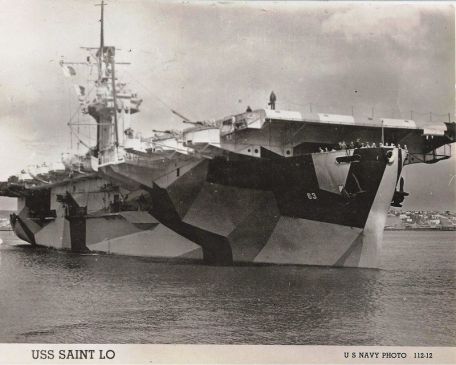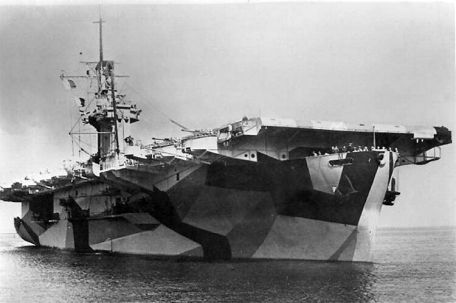History of the Holy Ro (CVE-63)
When the United States Navy (USN) needed a large, budget-conscious aircraft carrier fleet to fight in the Pacific during World War II (1939-1945), it turned to a new type of warship called a "companion carrier" . and the fleet Compared to aircraft carriers, these are simple "flat-roofed" ships with a smaller size and displacement - which dictates their limited aircraft stables. Additionally, they were slower to advance and had fewer self-defense measures installed to keep them light and speed up construction.
The U.S. Navy's Casablanca class became the largest number of aircraft carriers ever built -- fifty in all -- and one of their designs was the USS San Lo (CVE-63).
USS St. Lo was originally a merchant ship (Chapin Bay (AVG-63)) but eventually became an aircraft carrier. In April 1943, she was named USS Midway, but was renamed again in October, this time to USS Saint Ro (USS Midway was used by another, larger carrier design).
The warship was laid by Kaiser on January 23, 1943, and launched on August 17 of the same year. It was quickly tried and tested, and it entered service on October 23, 1943.
St. Lo and her sisters completed the relatively unobstructed flight deck, with the main projection becoming a starboard mounted island. Two elevators are used to transport the aircraft from the lower deck to the upper deck and vice versa. There is a single launch catapult system. The end-to-end design of the flight deck means that all waiting aircraft on the deck must be cleared before another aircraft can be allowed to land.
Carried up to 28 fighter jets of different makes and models.
Dimensions include 512.2 ft length, 108 ft beam and 22.3 ft draft. Power comes from 2 Skinner Uni-Flow 5-cylinder (triple expansion) steam reciprocating engines fed by 4 boiler units and producing 9,000 hp to drive 2 axles.
Top speed in ideal conditions is 19 knots and range is 10,240 nautical miles.
There are a total of 860 operators on board, plus an additional 50 to 55 crew members. Truly defensive weapons include a 5"/38 caliber dual purpose (DP) gun, 16 x 40mm Bofors anti-aircraft (AA) and 20 x 20mm Oerlikon anti-aircraft guns.
Like most wartime warships, the USS Saint Lo was deployed almost as soon as she and her crew were ready. This meant she was already a veteran of multiple Pacific cruises in support of Allied operations across the theaternamely, Saipan, Enivitok, Tinian, and Morotai. In October 1944, she participated (as part of "Taffy Three") at the Battle of Leyte Gulf (23-26 October), in which combined Australian and American forces met Imperial Japan. The battle ended in a decisive Allied victory, inflicting such damage to the Japanese navy that advancing troops were paralyzed.
About 300 Allied warships were engaged against about 67 Japanese naval ships, including only one fleet carrier (supporting three light carriers).
The USS San Lo was unlucky in combat events. After surviving an attack by a Japanese surface warship, the ship was the target of a major kamikaze attack - the fully loaded fighter jets crashed into the flight deck of San Lo, causing extensive damage, waiting for bombs, machine gun/cannon ammunition and fuel supply. The resulting fire and explosion - culminating in a massive explosion - destroyed the ship forever.
She sank in just an hour, taking between 100 and 113 crew members (about 434 were picked up by rescue boats).
On October 25, 1944, San Lo became the first Allied warship to be killed in a kamikaze attack. For her service in the war, the ship received a Presidential Unit Citation (Battle of Samar) and four Battle Stars.
USS St. Lo (CVE-63) Specification
Basic
Roles
- Aircraft/Sea Support
- Blue Water Operations
- Fleet Support
- Hunter
- direct attack
Dimensions
512.2 ft (156.12 m)
108 feet (32.92 m)
6.80m
Weight
7,900 tons
Performance
Performance
19 kn (22 mph)
10,237 nautical miles (11,780 mi; 18,958 km)
Armor
1 x 5" (130 mm) /38 caliber Dual Purpose (DP) Gun
16 x 40 mm Bofors Anti-Aircraft (AA) guns (eight turrets, two guns).
20 x 20 mm Oerlikon Anti-Aircraft Gun (AA) (20 single gun turrets).
Wing
Carrying up to 28 aircraft of different makes and models: fighter jets, dive bombers and torpedo bombers.




